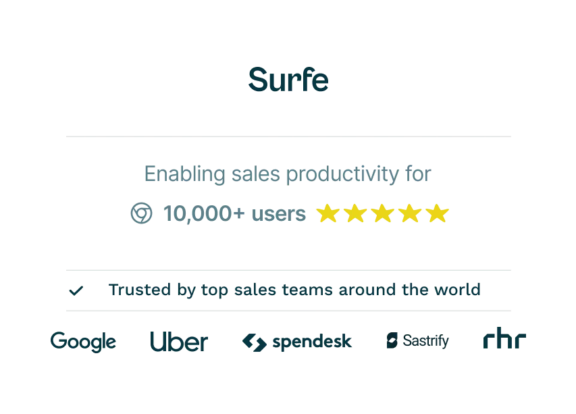Is the role of SDR broken?

Sales Development Representatives (SDRs) play a critical role in the sales process, performing almost 100 tasks a day on average, including social, call, voicemail, and email touches, all designed to nurture leads and close the sale.
However, technological advancements and shifting buyer behaviors, has led many in the business to worry that the role of the SDR role is fundamentally broken. Others claim that with the advent of AI in sales, the role isn’t broken, it’s evolving.
It’s a question we have been thinking about a lot, and this article delves into how market dynamics are reshaping the responsibilities and importance of SDRs in modern sales strategies.
Key highlights:
- Challenges Facing the SDR Model on a Daily Basis
- The Future of SDRs in Sales
- How to fix the role of SDR
If the role of SDR is broken, what has broken it?
Well, it’s not black and white and there’s no singular event that has broken the role of SDR. Over the past few years, the role of the SDR has been transformed significantly by new trends and technological advancements:
- Rise of Account-Based Marketing (ABM)
ABM focuses on targeting specific high-value accounts rather than broad markets. This strategy requires SDRs to adopt a more personalized and research-intensive approach, as they need to understand the business context of fewer, larger prospects rather than casting a wide net.
- Integration of Advanced Analytics and Big Data
The increasing availability and sophistication of data analytics tools allow SDRs to gain more insights into customer behavior and preferences.
This shift from intuition-driven to data-driven selling can make the SDR’s role more strategic and less about volume-based prospecting.
- Customer Self-Education and Informed Buying Decisions
With a wealth of information available online, buyers are increasingly well-informed, and often far along in their decision process before they even engage with a sales team. SDRs must now focus on adding value beyond the information that prospects can find themselves, changing the nature of interactions from pitching to consulting.
- Economic Fluctuations and Budget Scrutiny
Economic uncertainty forces companies to scrutinize their budgets more closely, impacting sales cycles. SDRs are required to navigate these complexities by understanding the financial implications of their products for prospects, aligning their pitches more closely with prospects’ economic realities.
- Remote Work and Digital Engagement
The shift to remote work has extended the digital transformation of sales processes. SDRs need to be adept at using digital communication tools and engaging potential clients without face-to-face interactions, which involves mastering new skills like virtual presentation and remote relationship building.
These five trends have had a combined impact on the role of SDR, but if you’re paying attention, you’re probably waiting for us to address the elephant in the room. In fact, the 6th point is one that has contributed to each of the previous 5 and is certainly the largest single impact on the working world in general, not just sales.
- Automation of Repetitive Tasks by AI
Artificial Intelligence is reshaping the SDR role by automating routine tasks such as lead qualification, initial outreach, admin, and follow-ups.
Whether AI has ‘broken’ the role of SDR is up for debate. Yes, it replaces many of the responsibilities of an SDR, but it also allows SDRs to concentrate on more complex aspects of the sales process, such as engaging with qualified prospects and crafting personalized approaches. AI tools like this one can handle high volumes of data more efficiently than humans, thereby increasing the speed and accuracy of the initial stages of the sales funnel and potentially changing the nature of what it means to be an SDR.

Challenges Facing the SDR Model on a Daily Basis
The landscape of sales development is continuously evolving. The convergence of technology, market dynamics, and shifting buyer behavior has notably impacted the traditional SDR model.
1. Buyer Numbness to Traditional Outreach
With the wealth of information available online, today’s buyers are often well-informed and can be indifferent to traditional sales tactics like cold calling and scripted emails. This change pushes SDRs to find innovative ways to add value, shifting from a pitch-centric approach to one that is more consultative and personalized. Focus on what the target needs by comparing them to your ICP.
2. Saturation Across Industries
As more companies have adopted similar sales strategies, the marketplace has become saturated with identical outreach efforts, leading to diminished returns. This saturation requires SDRs to differentiate their approaches to capture the attention of potential leads effectively.
3. The Burden of an Increasingly Complex Tech Stack
The introduction of advanced CRM systems, AI tools, and data analytics platforms has, paradoxically, both simplified and complicated the SDR role.
While these tools can enhance efficiency, they also require SDRs to possess a higher level of technical proficiency, learn to use new tools regularly, juggle credentials, and they bring along their fair share of technical challenges too. This is often a steep learning curve, all of which consumes time that could be spent engaging with prospects.
Each of these challenges necessitates a recalibration of the SDR role, pushing professionals to enhance their skills and adapt to a rapidly changing sales environment.
When you ask an SDR about which tools they’re using in their day-to-day:

The Future of SDRs in Sales
As the sales landscape continues to evolve, the future of Sales Development Representatives (SDRs) is poised for significant transformation. The automation of routine tasks by AI frees SDRs to focus on more complex and nuanced aspects of sales, such as deepening client relationships and tailoring solutions to specific business needs.
The indispensable human element in sales, understanding, empathy, and connection, cannot be replicated by technology. This means the SDR role is not obsolete, but is instead shifting towards more strategic, consultative functions that leverage human insight alongside technological tools.
Looking forward, SDRs will likely serve as strategic advisors who not only initiate relationships but also foster them through personalized engagement, powered by insights drawn from advanced analytics.
This transformation will require SDRs to develop new skills, such as analytical thinking and emotional intelligence, ensuring they remain vital components of the sales process in an increasingly digital world.
You armed with the knowledge you need to perform in the future as an SDR:

How to fix the role of SDR
As an SDR, it’s up to you to prove your role isn’t broken or unnecessary. The role is evolving and so must you. Here are our 5 tips for you to apply in your day-to-day to ensure you can keep performing:
1. Leverage Technology
If you’re not using AI and CRM tools to their full potential, you’re already behind. These tools aren’t just here for your convenience; frankly, you’re not going to get anywhere without them and it will remain you that is responsible for the drudgery of repetitive tasks like data entry and admin. If you’re not using AI in your working week, you need to find a way to implement it or risk falling further behind.
2. Enhance Research Skills
Generic pitches are a relic. You must dig deeper into market trends and customer needs. The modern SDR must act more like a consultant than a traditional sales rep, and this starts with research. Learn what your prospect needs, and tailor your pitch to their needs. Again, you can use tools to help here – tools that provide buyer intent data are a good place to start.
3.Build on Soft Skills
Your product likely isn’t the only one on the market. Often, the differentiator is the sales experience. Prioritize relationship-building and empathetic communication. The ability to engage a prospect on a human level can make or break deals.
4.Adopt a Multi-Channel Approach
Prospects are everywhere and available on multiple platforms: social media, emails, phone calls, in-person. If you’re not engaging them across multiple platforms, you are effectively conceding opportunities to competitors who are. Diversify your approach or risk missing out.
5. Continuous Learning
The sales world evolves rapidly. Stagnation is the fastest route to obsolescence. You need to stay updated on new tools, techniques, and industry shifts. View learning as an ongoing requirement, not a checkbox to be ticked off at training sessions.

Let’s Wrap It Up!
The SDR role has changed, and will continue to change in the future. By keeping up to date with industry trends, utilizing new technology, and focusing on providing value to prospects and clients, SDRs will be able to stand out from the crowd, hit their targets, prove their value, and thrive in the modern sales environment.

Want a secret weapon to save time and hit your KPIs?
Surfe can save you hours of time a week on CRM admin
FAQs:
What is a modern SDR?
Sales Development Representatives (SDRs) are inside sales representatives who focus solely on sales prospecting. Unlike sales executives (quota-carrying salespeople) who close new deals, SDRs reach out to new leads, qualify them and push them further down the sales funnel.
What makes a good SDR?
A good SDR should be curious, and able to adapt. The role is changing so fast that new skills need to be constantly acquired to stay ahead.
How can SDRs adapt to new technology?
SDRs can learn new technology by staying informed, reading up on new developments, consuming relevant content, and attending seminars and training sessions.


